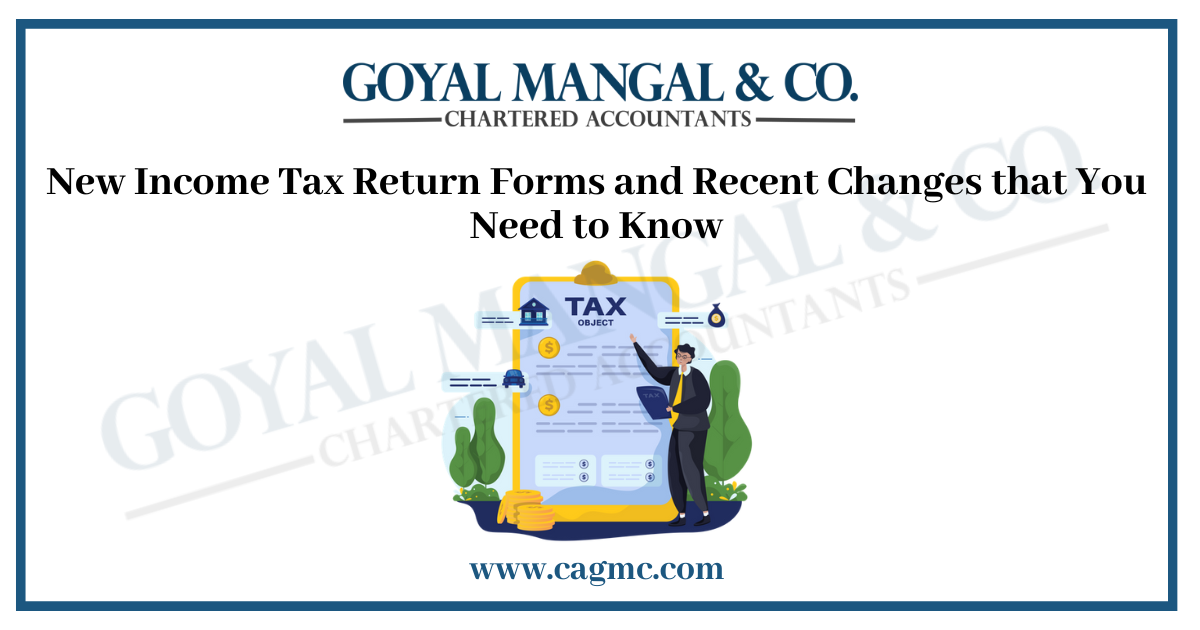
Income tax is a type of direct tax the central government charges on the income earned during a financial year by individuals and businesses. It is calculated based on the tax slabs defined by Income Tax Department. The Central Board of Direct Taxes (CBDT) has notified New Income Tax Return (ITR) Forms for the Assessment Year 2023-24 vide Notifications No. 04 & 05 of 2023 dated 10.02.2023 and 14.02.2023. These New ITR forms will come into effect from 1st April 2023 and have been notified well in advance in order to enable the filing of returns from the beginning of the ensuing Assessment Year.
|
Table of Contents |
What are Direct Taxes?
Direct taxes are those that are charged immediately on the income received. Individuals and corporations are subject to direct taxes. These taxes cannot be passed on to future generations. The income tax is the most important sort of Direct tax for individual taxpayers like you. This tax is levied once a year throughout the assessment year (1st April to 31st March). According to the Income Tax Act of 1961, you must pay income tax if your yearly income exceeds the minimum exemption level.
Need for the Income Tax Act
The primary source of income for the government is taxes. The revenue generated by taxes is used to cover government expenses such as education, infrastructure amenities such as roads and dams, and so on. Taxes are collected for the fundamental aim of generating adequate income for the state. Taxes have come to be seen as a tool by which the economic and social ideals of a welfare state may be attained. As a result, the Income Tax Act of 1961 became necessary.
The Central Board of Direct Taxes
The Central Board of Direct Taxes (CBDT) had earlier released the income tax return forms for the assessment year (AY) 2023-24. In the past, the Centre would notify the ITR forms either at the end of the financial year or at the start of the new financial year for the relevant financial year. The early notification of ITR forms for the current Assessment Year gives all stakeholders ample time to prepare. These New Income Tax Return (ITR) Forms will come into effect from 1st April, 2023 and have been notified well in advance in order to enable filing of returns from the beginning of the ensuing Assessment Year.
Different Income Tax Forms to File ITR Form
- ITR-1 SAHAJ: For individuals being a resident having total income up to Rs.50 lakh, having Income from Salaries, one house property, other sources and agricultural income up to Rs.5 thousand
- ITR-2: For Individuals and HUFs not having income from profits and gains of business or profession
- Form ITR-3: For individuals and HUFs having income from profits and gains of business or profession Form
- ITR-4: Sugam For Individuals, HUFs and Firms (other than LLP) being a resident having total income up to Rs.50 lakh and having income from business and profession which is computed under sections 44AD, 44ADA or 44AE.
- Form ITR-5: For persons other than:
- Individual
- HUF
- Company
- Person filing
- Form ITR-7: ITR-7 is meant for persons including companies required to furnish their return of income only under sections 139(4A), 139(4B), 139(4C), or 139(4D) of the Income Tax Act.
- Form ITR-6: ITR-6 is meant for companies other than those claiming exemption under Section 11 of the Income Tax Act, 1961.
- Form ITR-V: To be used in cases where the data of the Return of Income in Forms ITR-1 Sahaj, ITR-2, ITR-3, ITR-4 Sugam, ITR-5, and ITR-7 is filed but not e-verified (i.e., not verified electronically).
Changes after revised ITR forms
- It should be noted by taxpayers that there have not been any significant changes in the New Income Tax Return (ITR) Forms. Taxpayers will be pleased to know that there are no changes in ITR-1.
- In the other remaining forms, a new schedule has been added under the head of Capital Gains, for reporting Income from Virtual Digital Assets. This new schedule requires taxpayers to report the date of acquisition, date of transfer as well as cost of acquisition and the proceeds received on sale of VDAs.
- The ITR forms have also been updated to include more questions about the selection of the new tax regime. Taxpayers must now report if they opted for the new regime in the previous assessment year, and the assessment year in which they made the selection.
Conclusion
In order to further streamline the ITR filing process, not only have all the New Income Tax Return (ITR) Forms been notified well in time this year, no changes have been made in the manner of filing of ITR Forms as compared to last year. The notified ITR Forms will be available on the Department’s website at www.incometaxindia.gov.in.Early notification by Income Tax Department about the new ITR forms applicable for the Assessment Year 2023–24 would give adequate leverage to all of the stakeholders, including the taxpayers, tax professionals, and the e-filing portal.


